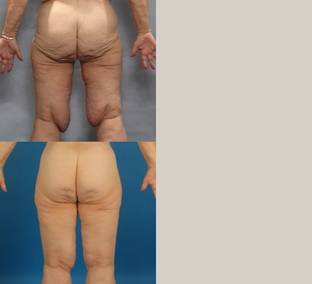
Figure 1. This photograph shows one of the patients included in the study; prior to, above, and after, below, medial vertical thigh reduction. The patient underwent a belt lipectomy prior to the thigh reduction.

INTRODUCTION Thigh reduction after massive weight loss is a difficult operation potentially fraught with complications. We present a medial vertical thigh reduction technique that is designed specifically to treat large massive weight loss thigh deformities and avoid the risk of the two most dangerous complications; labial spreading and permanent lymphedema.
MATERIALS & METHODS Surgical technique: A vertical ellipse is marked on the medial aspect of the thigh making sure that the top of the ellipse is posterior enough so that if a horizontal component is required to work out a “dog ear” superiorly, it will not pull on the labia and the femoral triangle region is avoided. The amount of horizontal excess to be resected at any point along the entire ellipse is based on trying to attain a “cone” shaped thigh with the widest aspect about 2 inches below the perineal crease and the narrowest aspect just above the knee prominence. At surgery the proposed ellipse of excision is liposuctioned aggressively to deflate the area but leave the underlying lymphatics as intact as possible. Prior to resecting, the edges of the proposed excision are “tailor-tacked” with staples along the entire ellipse, which will simulate the result of surgery before making any cuts. Adjustments are made accordingly and the ellipse is then resected and the wound is closed.
A retrospective analysis of patients who underwent thigh reduction in our practice from 2005 to 2007 was performed. Patients were included if they had undergone a prior belt lipectomy procedure and were excluded if they underwent other methods of thigh reduction. Patient charts and photographs were reviewed and the variables mentioned in the Result section were recorded.
RESULTS 12 patients fit the criteria mentioned above. Their average highest BMI was 56.22 and the average BMI at thigh reduction was 29.26. Average follow-up interval was 7 months (213.8days) with a range of 11 days to 2 1/2 yrs. Liposuction of the thighs was done along with belt lipectomy in 83%, prior to thigh reduction (interim liposuction) in 33%, and concomitant liposuction of other areas of the thigh during the reduction in 33 %. 33% had a small horizontal component added to the vertical excision to treat a small superior dog ear. 42% had minor wound dehiscence treated by conservative wound management, 17% had a seroma and one patient, 8.3%, had minimal scar hypertrophy. 75 % of the patients who underwent an interim liposuction procedure had some complication and the same was true of those who had a horizontal component added to the vertical excision. No incidence of hematoma, infection, skin necrosis, DVT, permanent lymphedema or labial spreading was noted. See figure 1 for a representative case.

Figure 1. This photograph shows one of the patients included in the study; prior to, above, and after, below, medial vertical thigh reduction. The patient underwent a belt lipectomy prior to the thigh reduction.
CONCLUSION The vertical thigh reduction technique presented here is based on the fact that most of the excess created by massive weight loss is horizontal in nature requiring a vertical excision. This places all the tension of closure in a horizontal direction thus avoiding potentially disastrous labial spreading. Avoidance of the femoral triangle, which contains the most important lymphatic station of the lower extremity, along with leaving behind as many lymphatic channels intact in the area of resection as possible also reduces the risk of permanent lymphedema. It is our conclusion therefore that the vertical thigh reduction technique presented here avoids labial spreading and permanent lymphedema.
Keywords: Body contouring, Thigh lift, Thigh reduction, lymphedema, labial spreading